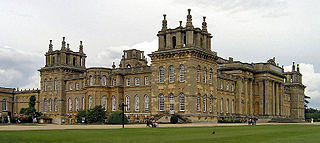
Blenheim Palace is a monumental country house in Woodstock, Oxfordshire, England. It is the principal residence of the Dukes of Marlborough, and the only non-royal, non-episcopal country house in England to hold the title of palace. The palace, one of England's largest houses, was built between 1705 and 1722, and designated a UNESCO World Heritage Site in 1987.

Thomas Wentworth, 1st Earl of Strafford, was an English statesman and a major figure in the period leading up to the English Civil War. He served in Parliament and was a supporter of King Charles I. From 1632 to 1640 he was Lord Deputy of Ireland, where he established a strong authoritarian rule. Recalled to England, he became a leading advisor to the King, attempting to strengthen the royal position against Parliament. When Parliament condemned Wentworth to death, Charles reluctantly signed the death warrant and Wentworth was executed.

Earl of Strafford is a title that has been created three times in English and British history.
Captain William Winde (c.1645–1722) was an English gentleman architect, whose Royalist military career, resulting in fortifications and topographical surveys but lack of preferment, and his later career, following the Glorious Revolution, as designer or simply "conductor" of the works of country houses, has been epitomised by Howard Colvin, who said that "Winde ranks with Hooke, May, Pratt and Talman as one of the principal English country house architects of the late seventeenth century".
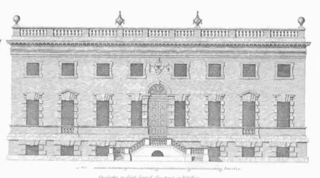
Colen Campbell was a pioneering Scottish architect and architectural writer, credited as a founder of the Georgian style. For most of his career, he resided in Italy and England.
This is a list of people who have served as Lord Lieutenant of Essex. Since 1688, all the Lord Lieutenants have also been Custos Rotulorum of Essex.
The year 1705 in architecture involved some significant events.
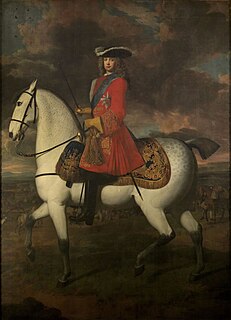
Lieutenant-General Thomas Wentworth, 1st Earl of Strafford, KG, known as Thomas Wentworth, 3rd Baron Raby from 1695 to 1711, was an English peer, diplomat and statesman who served as First Lord of the Admiralty.

Christoph Dientzenhofer was a prominent Bavarian architect of South-German, Austrian and Bohemian Baroque. He was a member of the famous Dientzenhofer family of architects, and the father of Kilian Ignaz Dientzenhofer.
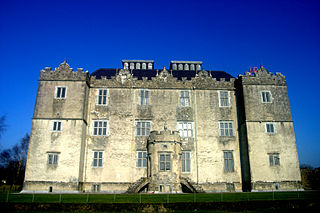
Richard Burke, 4th Earl of Clanricarde was an Irish nobleman and politician. He was the son of Ulick Burke, 3rd Earl of Clanricarde and Honora Burke. Knighted in 1602 for his exploits as leader of the English cavalry during the Battle of Kinsale, he would later serve as Governor of Connaught from 1604 to 1616, and as a member of the Privy Council of Ireland. Having established himself as the largest and most influential landowner in Connacht, his later life was characterized by animosity between him and an increasingly hostile and acquisitive Dublin government.

Wanstead House was a mansion built to replace the earlier Wanstead Hall. It was commissioned in 1715, completed in 1722 and demolished in 1825. Its gardens now form the municipal Wanstead Park in the London Borough of Redbridge.
Gentleman of the Bedchamber was a title in the royal household of the Kingdom of England from the 11th century, later used also in the Kingdom of Great Britain.
Wentworth Castle is a grade-I listed country house, the former seat of the Earls of Strafford, at Stainborough, near Barnsley in South Yorkshire, England. It is now home to the Northern College for Residential and Community Education.
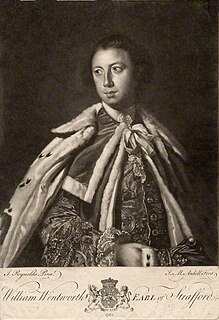
William Wentworth, 2nd Earl of Strafford, styled Viscount Wentworth until 1739 was a peer and member of the House of Lords of Great Britain.
There have been five baronetcies created for persons with the surname Wentworth, four in the Baronetage of England and one in the Baronetage of Great Britain. All creations are extinct.

Richard Child, 1st Earl Tylney, was an English politician who sat in the House of Commons between 1708 and 1734. Initially a Tory, he switched to supporting the Whigs after 1715. He held no Office of State, nor any commercial directorship of significance, but is remembered chiefly as the builder of the now long-demolished Palladian "princely mansion" Wanstead House, one of the first in the style constructed in Britain. In the furnishing of his mansion Child became the main patron of the Flemish painter Old Nollekens. He died in March 1750 aged 70 at Aix-en-Provence, France, and was buried on 29 May 1750 at Wanstead.

George Byng of Wrotham Park in Middlesex, was a British politician who sat in the House of Commons from 1768 to 1784.

Thomas Conolly was an Irish landowner and Member of Parliament.
James Essex (1722–1784) was an English builder and architect who worked in Cambridge, where he was born. He designed portions of many colleges of the University of Cambridge, and carried out major restorations of the cathedrals at Ely and Lincoln. He was an admirer of Gothic architecture, and assembled materials for a history of the style, though the book remained unpublished.












